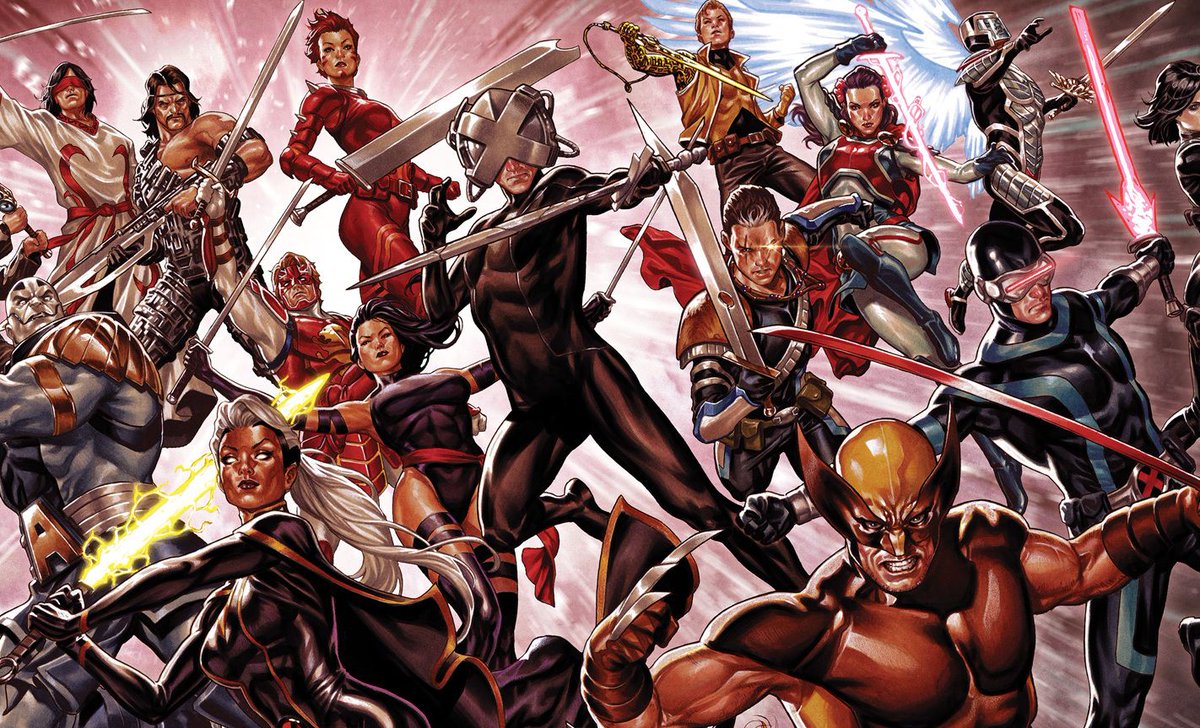
This X-Men article contains major spoilers for the Krakoa era comics.
Evolution. Mutation. Change.
These concepts have always been at the heart of the X-Men story. Even the fairly straightforward Silver Age adventures by Stan Lee and Jack Kirby made in the 1960s positioned mutants as the next stage in human evolution. Yet, rarely has the franchise made a leap as pronounced as it did in 2019, when writer Jonathan Hickman came on board to radically alter all of Marvel’s mutants with the game-changing House of X/Powers of X event books.
Five years later, with the release of X-Men #35, which is also the 700th issue of Uncanny X-Men as a whole, the Krakoa era has come to an end. The next era of X-Men books, From the Ashes, kicks off this summer and will see Marvel’s Merry Mutants returning to a world that hates and fears them. While that time-tested approach to resetting the X-Men status quo deserves attention, we need to take a minute and remember the Krakoa era for all it did well and the potential it failed to achieve.
The More Things Change…
The Krakoa era began with an appropriately uncanny image. Golden eggs under a rich, lush tree, with beams of sunlight piercing the landscape. Two figures emerge from the eggs, immediately identifiable as Scott Summers and Jean Grey. Before them stands Professor X, his face obscured by a strange helmet, posing like a mystical religious figure standing before his devout followers, who reach out to him in desperation.
“To me, my X-Men,” says Xavier in extreme close-up.
This scene from House of X #1, written by Hickman with art by Pepe Larraz and Marte Gracia, captures the tone of the Krakoa era: at once hopeful and terrifying, familiar and strange, and always striking.
In House of X, and its twin miniseries Powers of X, Hickman and his co-creators established a bold new status quo for Marvel’s mutants. The mutants now had their own sovereign nation in the form of Krakoa, the living island introduced in Giant-Size X-Men #1. Mutants could travel to Krakoa via gates that grow from plants, thus making the island accessible from anywhere on Earth or otherwise. Any mutant who came to Krakoa received instant immunity, which allowed the evil mutants and the good guys to begin again with a fresh start.
With this conceit came some daring elements. Most obviously, the Krakoa era made the X-characters’ constant deaths and resurrections into a feature, not a bug. Thanks to the powers of “the Five”—Hope, Proteus, Tempus, Elixir, and Egg (neé Goldballs)—dead mutants could be easily resurrected and have their memories restored via Cerebro. Essentially, the Mutants became immortal.
Although the resurrection protocols were (initially) limited to mutants, the mutants offered to the rest of the world miracle medicines and promises of peace, provided that the world recognized Krakoa’s sovereignty and allowed gateways to be planted on their ground. The mutants also used their gateways to colonize Mars, renaming it Arakko and making it the dwelling place of a heretofore hidden group of mutants.
Thanks to these and other developments, the mutants entered the next stage of their evolution. They no longer needed to fight for a world that hated and feared them. They could now fight for themselves, while giving humanity the opportunity to work with them but not relying on them. The mutants could take their powers to their full potential, and thrive as they never had before.
…The More Things Stay the Same
For as much as Krakoa changed everything for the mutants, the franchise still ran up against some of the same problems as always. Too many books, messy continuity, and unnecessary crossover events mucked things up from the start.
In addition to the flagship X-Men series, Marvel published a constant stream of spin-off books. Some had a clear raison d’être. X-Force by Benjamin Percy focused on the island’s defense team, led by a morally dubious Beast. Tini Howard’s Excalibur featured Captain Britain Betsy Braddock and other mutants dealing with magical threats. And X-Men: Red by Al Ewing fleshed out the story of Arakko, the new Martian home of Magneto and Storm.
However, others lacked strong direction and felt haphazard. X-Corp by Howard and Alberto Foche Duarte dealt with Krakoa’s financial dealings, with Angel, Penance, and Multiple Man in the lead, but the concept could not even sustain five worthwhile issues. Legion of X from Si Spurrier and Jan Bazaldua spun out of the interesting miniseries Way of X, in which Nightcrawler and Legion try to form a mutant religion, but quickly became a dull cop book.
And then there’s Wolverine. Look, no one’s going to expect Marvel to not produce a monthly Wolverine book. And Benjamin Percy does have some great ideas for the Canucklehead in the Krakoa era, including crashing a superhero auction in which someone is selling his severed hand to the highest bidder.
But Wolverine overload hit its peak with the absolutely awful twin miniseries X Lives of Wolverine and X Deaths of Wolverine, both written by Percy. In X Lives, illustrated by main X-Force artist Joshua Cassara, Jean and Professor X send Wolverine’s consciousness back in time a la Days of Future Past, to stop Omega Red, who can posses people in the past via the powers of Colossus’ evil brother Mikhail. Illustrated by Federico Vicentini, X Deaths mostly follows Moira MacTaggert, a key architect of Krakoa who turns against the mutants to become one of the era’s chief baddies, as she runs from a future Wolverine infected by the techno organic virus.
X Lives doesn’t make much sense (how do regular people sprout tentacles when they get possessed by Omega Red?), but it’s a fun look back at Wolverine’s many incarnations. And, as always, Cassara provides lush, detailed illustrations. X Deaths is a total mess, however, not least of all because many of Vicentini’s pages are incomprehensible.
The series ends by re-establishing Moira as a key big bad, complete with a team-up between Wolverine and his children X-23, Daken, and Scout. But it didn’t need to be a whole Wolverine mini-event, proving once again that too much Wolverine is a bad thing.
X of Crossovers
Even in the Krakoa era, the X-Men could not escape overblown and needless crossovers. X of Swords boasted a giant battle between the mutants of Krakoa and Arakko, with the fate of the mystical Otherworld on the line.
There’s much to admire in the way Hickman and his collaborators upend the expectations set up by what promised to be a series of one on one battles, with a scoreboard keeping track of which faction was winning. When Wolverine kills Summoner, the point goes to the latter as he fought to the death and Wolverine did not. Captain Avalon, the new identity assumed by former Captain Britain Brian Braddock, is challenged to kill more kittens than the Horseman War, which he refuses to do and loses. Despite these occasional moments of levity, most of X of Swords dragged on for too long, never quite making any of its big characters, such as Omniversal Majestrix Saturnyne and Captain Britain, as interesting as they were in classic Excalibur comics, rendering the entire event a slog.
Even worse was A.X.E.: Judgment Day, an event that tied the X-Men to the Eternals and the Avengers, at least in theory. In practice, A.X.E. was an Eternals storyline, in which the boring Kirby creations launch an attack on the mutants because of their resurrection protocols, and the Avengers get involved. Ever the excellent writer, Kieron Gillen does his best to add charm and philosophical heft to the proceedings, including a running theme of regular humans whose daily actions have massive effects.
However, a relatively straightforward story about the world responding to the X-Men’s immortality and the Eternals messing things up gets dragged out for 36 issues, most of which offer little advancement for the X-Men.
The one exception here is Sins of Sinister, spearheaded by Gillen, Spurrier, and Al Ewing. Sins of Sinister finds the wonderfully arch Mister Sinister unleashing his master plan with hybrid mutants called Chimera, teased all the way back in Powers of X. Between the smaller scale, the delightful central villain, and a solid creative team—which included artists Lucas Werneck, Paco Medina, and Alessandro Vitti—Sins of Sinister made for delightful reading. Even then, though, Sins of Sinister harkened back to the first X-Men crossovers during the Claremont era, Mutant Massacre and Inferno, rather than pushed things forward for a modern crossover.
The Messy Morals of Mutation
Ultimately, the failure of A.X.E. captures the primary problem with the Krakoa era: it never fully embraced or explored its big ideas.
The X-Men have been basically immortal since the first time Professor X revealed that he faked his death. Since then, almost every character has died and returned at least once. But instead of pretending that death was ever permanent in the Marvel Universe, the Krakoa X-Men embraced the concept of resurrection.
The initial books of the era even dealt with the knotty questions raised by resurrection. Mystique burns with anger when she realizes that her wife Destiny will never be brought back due to her precognitive powers — the one power set that isn’t allowed in the Krakoa era as it would endanger Moira’s carefully devised plan to save mutantkind from ultimate destruction. Havok must fight to get Madelyne Pryor resurrected after all the damage that she did in the past. When Rockslide resurrects differently, is he the same person or something different? Why does resurrection invite the brutal ceremony known as the Crucible, in which depowered mutants get slaughtered so that they can come back with their abilities?
All of these fascinating questions play out in the first couple years of the Krakoa era. But by the time A.X.E. released, immortality was just one more reason for humans to hate the mutants. Sure, we got a cool splash page in which the mutants resurrect Captain America, the first human to receive the honor. But the moral debates that followed got brushed aside with a few lines of dialogue.
In fact, almost all of the relationships between mutants and humanity were watered down by the end of the era. The Fall of X storyline, which put an end to the Krakoa era with the concluding miniseries Fall of the House of X and Rise of the Powers of X, tried to complicate the simple good mutant/bad human binary by having Xavier join the machine/human organization Orchis, the central evil faction of the entire Krakoa storyline. But that turned out to be nothing more than a plot juke so that Xavier could speak with Moira, thus sewing the whole thing up neatly.
Krakoa began with so much more promise. By giving the mutants their own sovereign nation, Hickman and his co-creators pushed the minority metaphor into a new realm. The mutants demanded respect on a legal level, and various nations’ refusal to negotiate and recognize the country stemmed from just simple fear and bigotry. It was, in their mind, an act of national survival.
Recall 2020’s X-Men #4, by Hickman and Leinil Francis Yu. As Magneto, Apocalypse, and Xavier meet with world leaders to discuss their relationship with Krakoa, Gorgon and Cyclops fight off the assassins sent to kill the mutants. Xavier showed a level of pragmatism unheard of even at his jerkiest, while Apocalypse and Magneto seemed rational, even in their arrogance. The moral lines shifted.
But by the end of the era, the moral lines were more or less clean. Humans hated mutants, who once again had to use their powers to defend themselves and the world. Nothing was learned. Nothing really changed.
The Audacity to Evolve
X-Men: Hellfire Gala (2023) ends with Charles Xavier lying on the beach of Krakoa, beaten and broken. The annual celebration of mutant culture, which climaxed with the election of a new X-Men team, was interrupted by an attack by Orchis that devastates the island and the foundations of the mutant nation. Hundreds of mutants died without hope of resurrection, and Xavier pushed the survivors off the island.
In the final pages, Xavier pleads with Rogue, leaving one last command for his remaining student: “Now leave me and go avenge them! Avenge Krakoa.”
Of course, it isn’t quite as simple as all that and, over the issues that followed, dead X-Men came back to life, Professor X solved problems with a psychic conversation, and Jean summoned the Phoenix Force.
In other words, Krakoa started with a bold new take on the X-Men and ended by revisiting the greatest hits. That’s the nature of superhero storytelling. If not even Chris Claremont at the height of his powers could let Jean Grey die and Scott Summers retire, what hope do those following Hickman have?
The X-Men finally defeat Orchis at the end of Fall of X, but they are once again without a home. From the Ashes takes things back to basics but the premise looks promising, with multiple mutant teams operating in cities across the US. Best of all, the new books are led by compelling creators such as Jed MacKay, Gail Simone, Eve Ewing, Collin Kelly, and Jackson Lanzing. Certainly, they’ll come up with some exciting new takes on the mutants to make them feel fresh and compelling all over again.
Let’s be clear: it’s not the end of the Krakoa era, nor even the reset to a more familiar status quo that disappoints. It’s the part in the middle, when X-Men comics had compelling new concepts and the space and time to explore them. More often than not, those ideas were drowned out by a morass of spin-offs, crossovers, and formulaic story beats, leaving so much of the potential of the era unrealized.
Evolution. Mutation. Change.
These concepts have always been at the heart of the X-Men story, but they rarely drive X-Men comics themselves. The Krakoa era offered a brief chance for the franchise to grow in compelling ways, but it fell short, refusing to fully embrace the conceit of mutation and change itself. But with From the Ashes now on the horizon, we once again dare to hope.
X-Men #35 is out now.
The post The X-Men Krakoa Era Never Reached Its Full Potential appeared first on Den of Geek.





